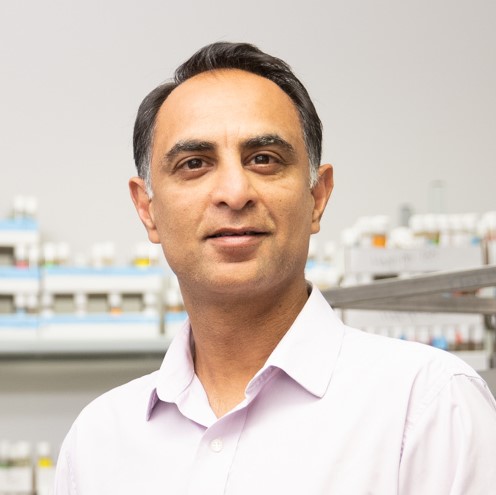by Buck Institute
May 14, 2021 . Research
Studying Alzheimer’s disease in fruit flies? You bet!
A recent $533,000 federal grant to the Buck Institute supports basic research to identify targets for new therapeutics based on how diet and aging influence Alzheimer’s and other neurodegenerative diseases. Here’s how it came together:
 The first discovery happened in the Kapahi lab where researchers showed that dietary restriction protects fruit flies that have been genetically modified to overexpress tau, one of the proteins implicated in Alzheimer’s disease. Postdoc Sudipta Bar, PhD, found the Spartan diet improved survival and reduced functional decline in the affected animals. (The Alzheimer’s fly has impaired movement, brain degeneration, and a significantly shorter lifespan than wild-type controls.)
The first discovery happened in the Kapahi lab where researchers showed that dietary restriction protects fruit flies that have been genetically modified to overexpress tau, one of the proteins implicated in Alzheimer’s disease. Postdoc Sudipta Bar, PhD, found the Spartan diet improved survival and reduced functional decline in the affected animals. (The Alzheimer’s fly has impaired movement, brain degeneration, and a significantly shorter lifespan than wild-type controls.)
Then associate professor Birgit Schilling, PhD, had her lab identify some of the specific changes that occurred in proteins in the brains of the affected flies. To make the fly data more relevant she brought in a collaborator, Emory University associate professor Nicholas Seyfried, PhD, who had data from more than 2000 brain samples of human Alzheimer’s patients. Crunching the data from both sources revealed 47 common genes at play in both species.
 Once more, the research came back to the fly with the goal of identifying the genetic mechanisms by which dietary restriction, which has been shown to extend lifespan in mammals, improves Alzheimer’s pathology. “It’s an exciting time in the lab because we are finding more disease-based human relevance to our work,” says Buck professor Pankaj Kapahi, PhD, the lead scientist on the two-year grant. “The federal funding is allowing us to bridge our work in aging and diet to Alzheimer’s, a subject which has been overlooked. In addition to identifying new targets for therapeutics, the research could help highlight lifestyle factors that are relevant in neurodegeneration.”
Once more, the research came back to the fly with the goal of identifying the genetic mechanisms by which dietary restriction, which has been shown to extend lifespan in mammals, improves Alzheimer’s pathology. “It’s an exciting time in the lab because we are finding more disease-based human relevance to our work,” says Buck professor Pankaj Kapahi, PhD, the lead scientist on the two-year grant. “The federal funding is allowing us to bridge our work in aging and diet to Alzheimer’s, a subject which has been overlooked. In addition to identifying new targets for therapeutics, the research could help highlight lifestyle factors that are relevant in neurodegeneration.”
Studying the molecular roots of Alzheimer’s disease in humans is a heavy lift. The disease develops over years and is hard to pin down. No reliable, noninvasive biomarkers exist for the memory-robbing disease and brain biopsies in living patients are almost always a non-starter. Enter the mighty fruit fly; even though it lives for just 60 days, it shares many biological pathways with humans and can be genetically engineered to have Alzheimer’s. Experiments to identify signaling pathways responsible for pathology can be done quickly at far less expense.
Bar, who came to the Kapahi lab in 2018, says the flies that express the mutant tau protein appear to be very sensitive to a rich diet. One of the pathways he is studying involves the role of brain glycogen in Alzheimer’s. Usually studied in the liver, glycogen is a substance deposited in tissues as a means of storing carbohydrates. When glycogen is not fully broken down it can lead to glycogen storage disease, which impacts the immune system and can lead to scarring of the liver and weak muscles.
Glycogen is present in the brain at much lower concentrations than in the liver or muscle, but Bar says its impact can be significant. “We look at glycogen as a back-up battery that can supply energy to the neurons,” he says, explaining that focusing on genes involved in glycogen turnover produced preliminary data suggesting that enhancing glycogen metabolism rescues neurodegeneration in the fly. “Researchers haven’t focused much attention on brain glycogen,” says Bar. “It could be an excellent target for protecting neurons, which hasn’t been explored before.”
“This grant allows us to focus on the diet’s impact on metabolism, the integrity of our DNA and the life cycle of neurons,” says Kapahi. “All of these processes are known to affect Alzheimer’s and aging. It’s a perfect example of how basic research in aging can be accelerated to find treatments for human diseases. We have already identified some novel compounds that can protect our Alzheimer’s fly model.”
In addition to Schilling and Seyfried, who are included in the grant, Kapahi plans on taking advantage of the Buck’s collaborative environment by bringing assistant professor Tara Tracy, PhD, into the project. Tracy studies the impact of accumulated tau on synapses, the specialized structures involved in transmitting information between neurons. Her work is done in mice and in human cell cultures.
Science is showing that while chronological aging is inevitable, biological aging is malleable. There's a part of it that you can fight, and we are getting closer and closer to winning that fight.
Eric Verdin, MD, Buck Institute President and CEO